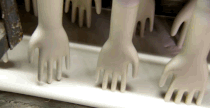Tour The Creepy Factory Full Of Hands Where Rubber Gloves Are Made

Inside a glove-making factory.
Rubber gloves have a history in the medical field, the food industry, and even in the criminal business. They protect us from diseases and contamination and keep us from leaving finger prints at the scene of a crime.
The world uses an estimated 100 billion rubber gloves each year in the medical business alone. To produce this kind of quantity, large factories will produce up to 45,000 rubber gloves per hour!
Rubber gloves are manufactured in surprisingly creepy hand factories. Here’s an inside peek into these hand-filled factories and how rubber gloves are made. Science Channel’s great series “How It’s Made,” shows the process by which many products we use today are mass produced and is the source for most of the information in this post. They also have videos on how chocolate chip cookie dough, lace, and soap sculptures are made, among many others.
The factories use dozens of ceramic or aluminum hand-shaped molds attached to conveyor belts. The conveyor belts move the reusable hands to various dipping stations. The first two stations, shown below, are solutions first of water and soap and then bleach that remove any residual material from the former run.
After the hands are scrubbed clean and dipped into a vat of hot water, they enter a chemical bath. The chemicals coat the hand molds that then enables the liquid rubber to stick to the hands. The rubber substance won’t adhere to ceramic directly. Watch the chemical coating process below.

After that, it’s time for the rubber, which manufacturers fortify with stability-enhancing chemicals. As seen below, the hands spin after the rubber coating to remove any drops.

If allowed to dry at room temperatures, the liquid rubber will be weak and easily break. To strengthen the rubber, the factories bake it in an oven, shown below. This process, called vulcanization, provides the incredibly stretchy, durable, and flexible rubber gloves we know so well.
Following baking, the hands are washed, dried, and then spin through brushes that roll up the cuffs of the gloves that have now formed on the hand molds. This is an important step, because it makes the gloves easy to remove from the hands.
After the rubber is dry and the cuffs are rolled up, it’s time to remove the gloves. This is either done manually, as shown below, or by machine. Workers will remove gloves made of synthetic rubber by hand because those gloves are stickier than traditional latex. Gloves made of latex can easily be sucked off of the hands with some pressure and air.
The final steps before packaging involve checking the gloves for any weak spots, holes, or other deformities. These tests include inflating the gloves with air, as seen below, and also filling some with water.
Finally, after surviving the creepy hand factory and passing thorough testing, the gloves are ready for packaging, shipment, and use. Whether you’re performing surgery, prepping burritos, or making ridiculous-looking water balloons, you now know how these handy gloves are produced.
See the entire clip from the Science Channel’s “How It’s Made.“
Read more stories on Business Insider, Malaysian edition of the world’s fastest-growing business and technology news website.



